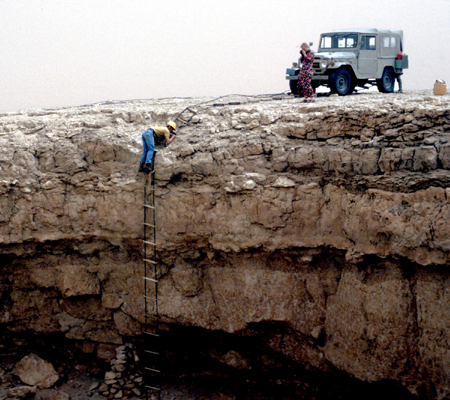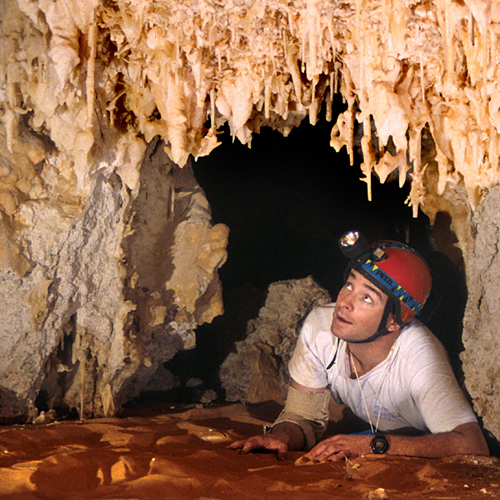A book about caves, camaraderie, Bedouins and the secrets hidden
beneath the sands of Arabia
 Underground
in Arabia Underground
in Arabia
John Pint
ISBN:
978-0-9701157-5-1
174 pages,
32 illustrations
Selwa Press,
2012
Born
and raised in Dhahran,
I thought I had seen most of the natural wonders of the Eastern kingdom
from the towering dunes of the Rub’ Al Khali to the pristine reefs of
the Gulf, so it was a true surprise to read the manuscript for John
Pint’s Underground in Arabia. I had visited the Jabal Al Qara caves in
Hofuf and knew of a few shallow holes in the jabals around Dhahran but
I never suspected the scope and beauty of the caverns that existed
beneath the desert, nor did anyone else.
In 1983, John Pint, an American teaching English at the King Fahd
University of Petroleum and Minerals (KFUPM), was wandering around the
flat, featureless desert north of Riyadh when he discovered a hole the
size of a serving platter. Air was blowing out of the hole, the sign of
a cave below. With the aid of a chisel, he and his friend Dave Peters
enlarged it enough to squeeze into. Lowering themselves on a rope tied
to the bumper of a truck they descended into an underground labyrinth
that had never been seen before by any human. Even the Bedouin didn’t
know of its existence. Thus began John’s twenty-five year quest to
discover the deepest, darkest passages underground in Arabia.
John Pint squeezing into the
enlarged hole of his first discovery, Dahl
Sultan
John
first arrived in Dhahran in 1981 and soon met up with one of the
earliest Arabian cavers, the long-time Aramcon Will Kochinski. Will and
a few others had been exploring the desert caves of the Eastern
Province for several years but, as he admits, they didn’t know about
accepted practices, so they improvised.
In Will’s own words, “To descend the forty feet into Jibu Al Kaliqa, an
enormous pit about 225 feet across, we built a rope ladder which was
made of several hundred feet of discarded polypropylene rope and we cut
60 or 70 steps out of plywood. Now, the way we secured them to the rope
was just by putting a nail through the twist in the rope into the end
of the step and then we rolled it up. So if you didn’t get killed by
the fall, you’d at least get stuck with the nails. Now sometimes, those
nails came out, but fortunately, there were so many of them that you
could always go to the next step. Still, it was fairly common that you
would grab the rope and get stuck by a nail. It was a big, ungainly
contraption that took up half the truck and when it was rolled up, it
would bounce around and punch holes in everything.”
“It was very dangerous and I would never, ever, do something like that
again. Fortunately, when John, Bruce Davis and other NSS cavers arrived
on the scene, we learned the proper techniques for using caving rope
and jumar-type ascending devices.”

Using
a ladder made of polypropylene rope and plywood rungs.
"If you
didn't get
killed by the fall,
you'd at least get stuck by the nails."
John and Will visited many desert caves in the area but they were all
very bland with not a stalactite or stalagmite to be found. This all
changed the day John descended into Dahl Sultan and the wondrous caves
and lava tubes he went on to discover will amaze and delight the most
claustrophobic reader: Massive stalagmites, delicate crystalline
natural sculptures, glittering silica fountains, and vast
cathedral-like caverns that rival the likes of the most famous caves in
the world. And of course, the things he found within these passages are
absolutely fascinating. The mummified remains of a 2000 year old fox,
human skulls, and ancient boomerang-like throwing sticks are just a few
of the tantalizing artifacts that will inflame your imagination and
make you wonder about the undiscovered treasures waiting to be found.
Somewhere in the thousands of still unexplored passages are there
fabulous cave paintings, mummified hominids from 10,000 years ago or
the graffiti of some long-forgotten people?

Lying
on a bed of red sand deep inside Whistling Teapot cave, Mike
Gibson admires a lavish display of gravity-defying helictites. This
cave has the "tightest entrance in Arabia." See the video
on the sidebar.
This book is about more than caves, it is also about the camaraderie of
John’s fellow cavers and the extravagant generosity of the many Bedouin
that he encounters on his quest to discover the secrets hidden beneath
the sands of Arabia. It is a wonderful read, as delightful as it is
informative.
I’m
pleased to announce that Selwa Press has just published Underground
in Arabia and it is now available in print as well as an e-book in
Kindle or Nook format. You can purchase it from Amazon
(http://www.amazon.com/Underground-Arabia-John-Pint/dp/097011575X) and
coming soon to Barnes and
Noble. To find more information visit our website at
www.SelwaDigital.com.
Tim
Barger
(Tim
Barger lived for most of his first 33 years in the kingdom and is
the publisher of Selwa Press.)
|

